Hydra’s descriptions of 16" gear inches are inaccurate, at least according to the official specs. Check out the savedbybikes.com link shared by Blackstridaaustria and also areaware.com.
Sorry for the mistake.
The high gear with 16" is higher than the orginal Strida one.
Regards.
Hydra.
Here is the opinion of Mark Sanders about the ATS and Schlumpf versions of speed-drive:
Hmm. Are there differences between the bottom bracket of the Strida 5.2 and the DS? Was playing around with the idea to do a 1 to 1 swap of the ATS for the Schlumpf to do a comparison before I reinstall it on the Strida 5.2.
I think the BB shell is the same on all 5.x Stridas.
Hi Blackstridaaustria,
Just out of curiousity, as we know that you have anodised many parts of your Strida into black, why didn’t you order the speed-drive kit with black crank arms + black easy-shift levers instead of the one with sliver crank arms from Schlumpf? ![]()
Amuro
Hi Amuro,
nice question…
Meanwhile a lot of time went by, at first was the Schlumpf, then the “black phase” overwhelmed me, inspired partially by users of the HK Strida Club, who are customizing their bikes in various ways.
At the moment are, of course, black crankarms and black kick shift levers to be found on my black Strida.![]()
These black parts were brought by my dear Mrs. Blackstridaaustria directly from Switzerland to Austria as a present. ![]()
The silver ones I kept for Mrs. BSA’s brushed silver Strida, maybe the time brings a second Schlumpf?
Any other questions?
Warmest regards
Hi Blackstridaaustria,
Oh I see. So every part of your Strida is in black now. ![]()
Best regards,
Amuro
Did it again…

…so the silver Strida is Schlumpf powered also ![]()
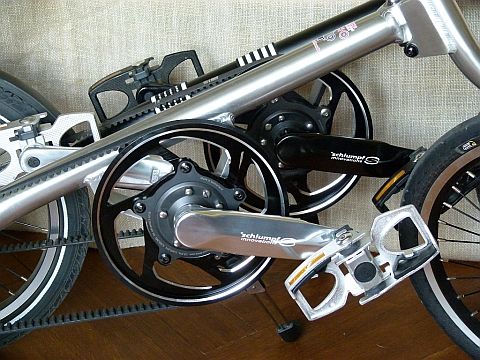
Cheers!
Hello,
I recently wrote to ATS to ask them if a Speed-Drive for my Strida is available direct or through a US distributor. Here is the reply I received yesterday:
Dear Richard,
We don’t have distributer in USA.
We can sale directly. But U have to pay the freight cost (Ship out from Taiwan).
And U have to make sure, U can apply the ATS-speed drive on your bike. Pls check your bike first:
(1) Is your bike can fit our standard BB?
(2) Do U have belt chainring on your Strida already? (Right length of belt and chain ring…)
(3) Do U know how to install ATS-speed drive?
Best Regards
Mark Liu
Their prompt and considerate reply is a big step forward, but apparently they do not have a Strida-specific installation kit available, as Schlumpf does.
I am not certain how to answer their three questions for my single-speed 2010 Strida 5.0. I would greatly appreciate any advice on how to proceed.
Thanks and Regards,
Richard
Dear Richard,
I’m sorry to say, but there will be big problems to find/create the missing parts.
The standard ATS bracket is made for bottom bracket shell diameters of 33.6 - 34.5mm, according to their website.
The Strida bottom bracket shell has a diameter of ~ 52 mm, you will need an excentric bottom bracket mechanism similar to that you have now in your Strida.
Similar, not equal, the new one has to be more broad!
So I think it’s not possible to modify the existing bracket mechanism…
The 80 teeth beltwheel you will need is not available as a spare part, as far I know.
(I will try to verify that and ask Ming about it.)
Btw, Mr. Schlumpf had obtained these 80 teeth beltwheels from Ming Cycle directly, he did not make them himself.
Mr. Schlumpf also told me that these beltwheels were not manufactured precisely; therefore he had to chisel them out ~ 0,4 mm.
The belt should be no problem.
Just like the Schlumpf drive, here is an interesting video about the process:
http://www.youtube.com/watch?v=0teCnQJskgQ
Please note: The video is showing a chamfering procedure, done by a hand milling tool.
This procedure is needed for all bikes, except the Strida (due to the excentric bottom bracket).
Best regards,
BSA
Below a few pics of the new buttons and plates:

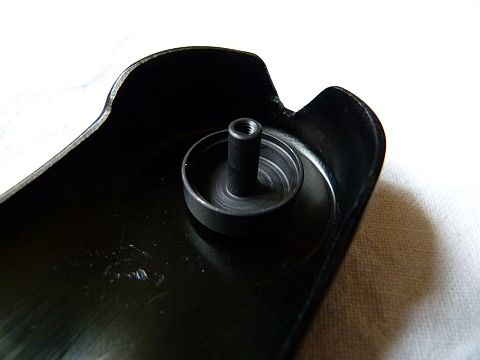
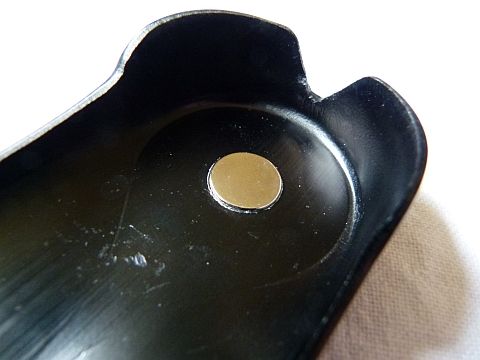

Detail for our weight-weenies:
The new black buttons are much more heavy than the old silver ones; ~ 9 grams instead of ~ 3 (per piece!) ![]()

12 more pics of the Schlumpf speed drive are here:
![]()
Hi BSA,
I have a bad experience with the old kickplates, I tried them twice but I removed them twice because of the bad shifting: I regularly found myself "pedalling in the air " when the traffic light was becoming green. It appeared very difficult to balance the preload between the 2 kickplates.
A big advantage of the kickplates is that you can’t loose the shift buttons… ![]()
Did Schlumpf reduce the stiffness of the kick plates or are the the magnets so strong that they can always keep the kickplates in contact with the crank levers?
Hello Bietrume,
I did not notice any difference in the plates.
The magnet seems indeed strong, at least for it’s thickness, just ~ 0,8 mm.
I suggest to ask Mr. Schlumpf himself about your problem:
support[at]schlumpf.ch
(Please replace [at] with @)
Above new plates (and the drive) are not for myself, they will be sent to an American Strida fan.
How to „do the Schlumpf“ 2-speed conversion DIY
(Version 2.0 with more details)
Important note: Ming cycle definitely recommends assembling neither the Schlumpf speed drive nor the ATS speed drive yourself. There will be no warranty by Ming cycle!
Personal note: The ATS speed drive is not available as a retrofit kit for Strida. The Schlumpf speed drive kit will be delivered with five years full warranty.
Before doing anything else, please check the wear of the freewheel! It would be senseless to install a two-speed drive together with a worn-out freewheel!
The required tools and detailed information can be found here:
Strida workshop tool guide
Before starting, mount your Strida into a bike stand, or, if you don’t have a stand, turn your bike upside down. Here’s an example of how that can be done:
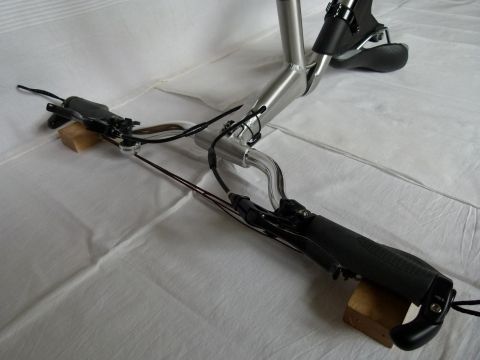
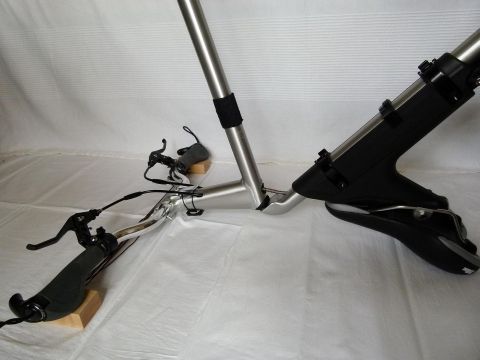
Take two small blocks of wood and put them below the grips. If the saddle is in a lower position than shown in the pics, take some old books or another, bigger block of wood and put it under the saddle. (The cord between the small wooden blocks is helpful to keep the correct distance, but is not implicitly necessary.)
Let’s start 
-
Loosen the big groove nut of the bottom bracket by using a 60 mm hook key

-
Remove the pedals by turning clockwise (for the left pedal), and turning counterclockwise (the right pedal) with a 15 mm flat wrench (caution: accidentally, a 16 mm wrench is shown here – that’s the wrong size!)


-
Remove the belt tension bolt (and the kickstand) with a 6 mm Allen key
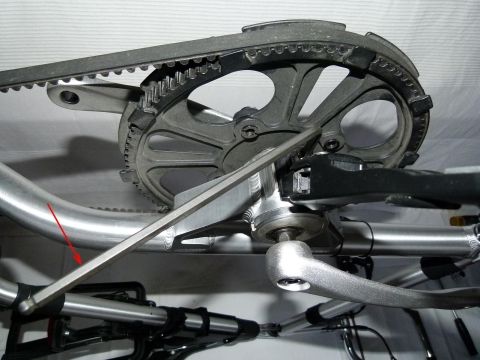
-
Remove the left crank
a. Remove the crank cover and the crank bolt with a 8 mm Allen key
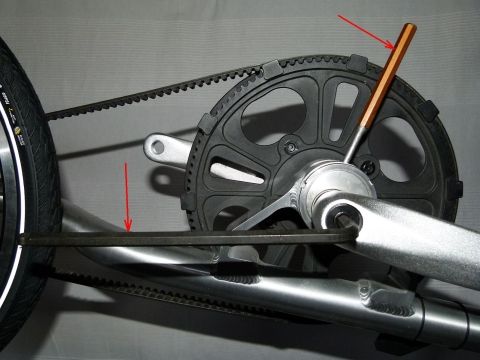
b. Remove the small conical part of the crank extractor tool (depending on the used tool!) and turn the bolt inside the tool out as far as possible
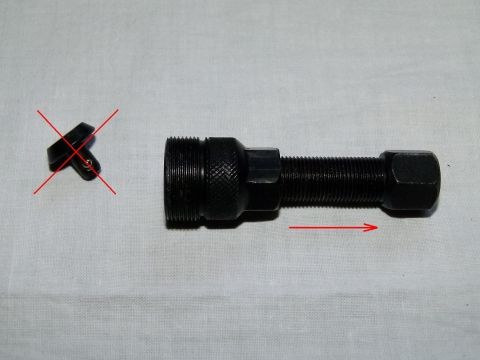
c. Screw the tool, as far as possible, in the crank thread

d. Now screw the bolt mentioned in point b) in the tool, the extractor tool should be held with one flat wrench (16 mm), the bolt should be turned with another wrench (15 mm), in brackets are the wrench sizes for the example BBB tool BTL-14
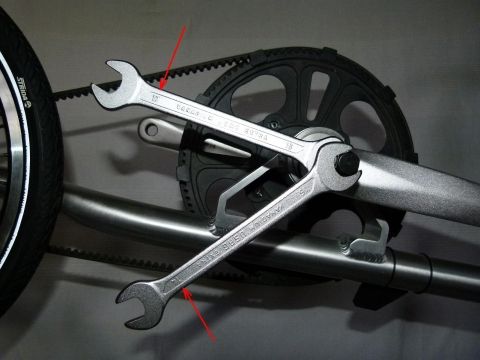
e. The crank will now be extracted from the bottom bracket axle
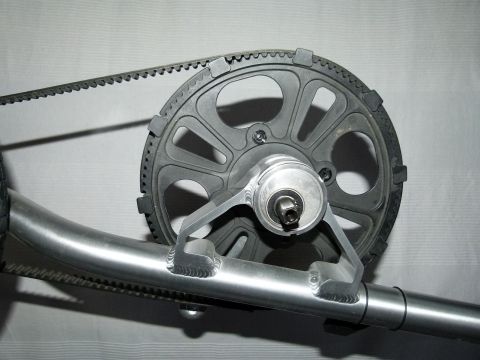
-
Remove the rear wheel bolt, the metal and the plastic washer, the counterpart of the magnet, the two plastic washers below the magnet’s counterpart and the so-called magnet spacer, part.nr. 338, with a 4 mm Allen key (caution: if the magnet spacer is bent or broken, replace it!)

-
Remove the rear brake caliper by turning the two caliper bolts with a 5 mm Allen key (caution: The two washers, part nr. 7 of drawing 340-04, between caliper and frame might fall down and get lost!)


- Remove the snubber bolt, snubber and the corresponding washer by using a 5 mm Allen key (caution: Do not lose the washer!)

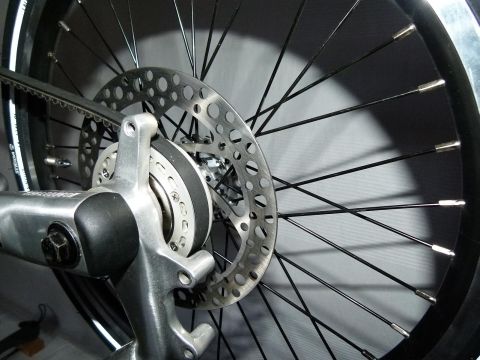
-
Release belt tension by turning the excentric bottom bracket, usually the bracket should be turned clockwise (seen from the left side) to release, but the bottom bracket can be mounted upside down. If your bottom bracket is mounted that way, it must be turned counterclockwise to release tension.
(Further information is here:
Strida for someone tall
18" Wheel Upgrade: not that easy…
How much play in Strida 5 belt?)
The bottom bracket can be moved easily by inserting a 6 mm drift punch in the tension (kickstand) bolt thread. -
Carefully pulled sideways, while turning the beltwheel, the belt can now be removed from the belt wheel.

-
Now remove the rear wheel, the belt should be pushed near the locking mechanism of the frame

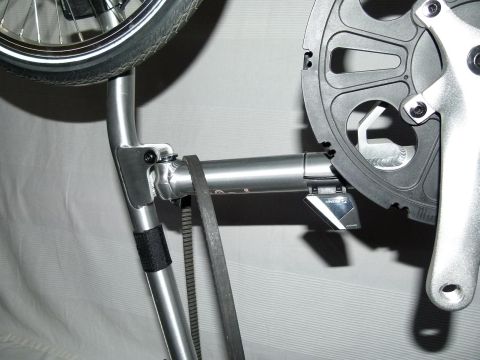
-
Remove the bottom bracket groove nut

-
Pull out the old single-speed bottom bracket from the right side of your Strida
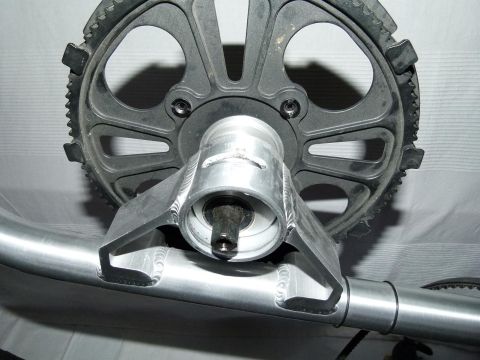
As everything except the belt has been removed now, I suggest to have a break and think about the next steps. It’s time to open the frame to remove the belt, but this is a bit dangerous, the Strida will become unstable. To avoid any damage we should open the frame for a short time only.
- Changing of the belt:
a. Move the old 1440 belt as near as possible to the locking mechanism
b. Take the new 1360 belt in the right hand and grab the bottom tube simultaneously

c. Grab the steering tube with the left hand below the frame lock

d. Open the frame lock with the left thumb, then push the bottom tube downwards with the right hand
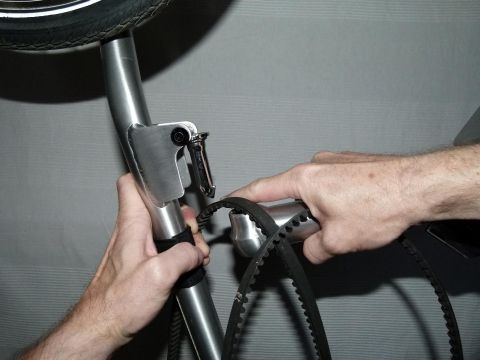
e. Let the old belt fall down with a little help from some spare fingers ![]()

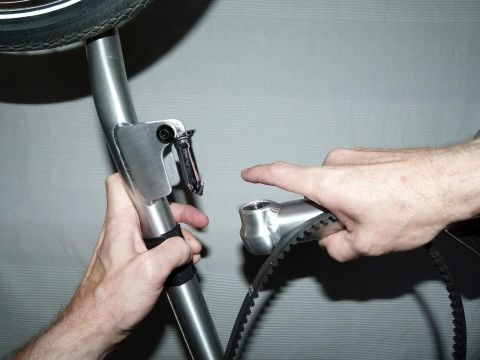
f. Contrive the new belt over the bottom tube
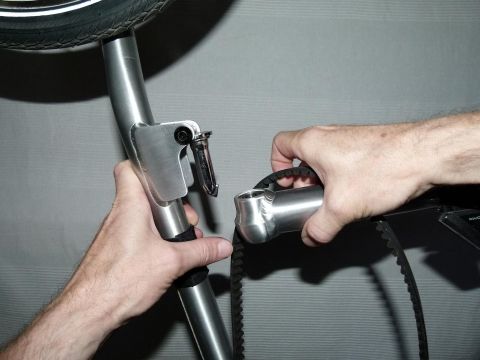

g. Lock the frame again

-
Put the belt over the freewheel and push the wheel onto the axle (caution: do not clamp the belt between the freewheel and the lower caliper mounting of the frame)

-
Remove the big groove nut from the Schlumpf drive, push it into the bottom bracket mount, hold the belt between drive and frame and be careful not to clamp the belt. Secure the drive with the groove nut, do not tighten it yet

-
Move the drive to the lowest belt tension position and pull the belt over the belt wheel from inside
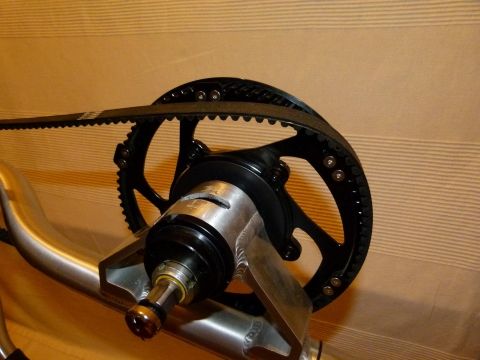
-
Unscrew the kick shift button and the crank bolt with its washer
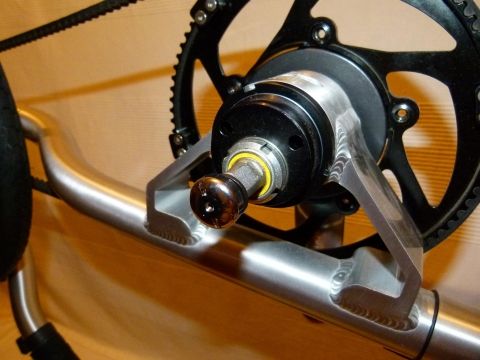
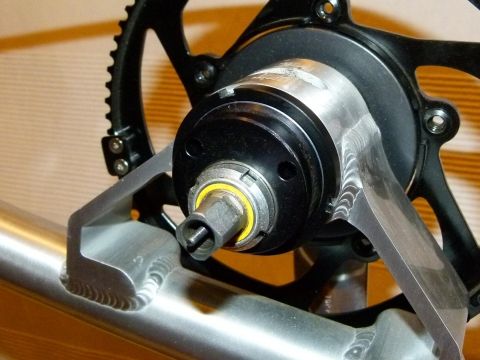

-
Push the single crank onto the axle and secure it with bolt and washer (caution: do not use a thread locking compound like Loctite on Schlumpf parts!)
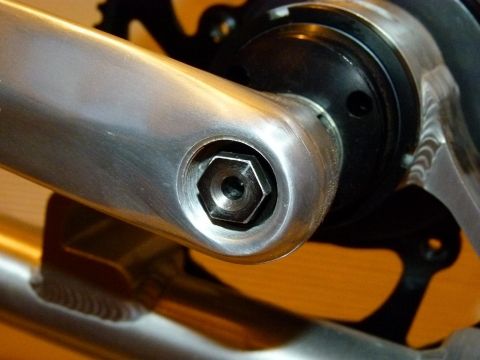
-
Tighten the crank bolt to a torque of 50-55 Nm (40,6 lb ft) by using a 14 mm socket wrench (it’s recommendable to follow the instructions of the Schlumpf speed drive manual, chapter B-4/Axle bolts, to be found here: haberstock-mobility.com/Manual Schlumpf speed drive.pdf)
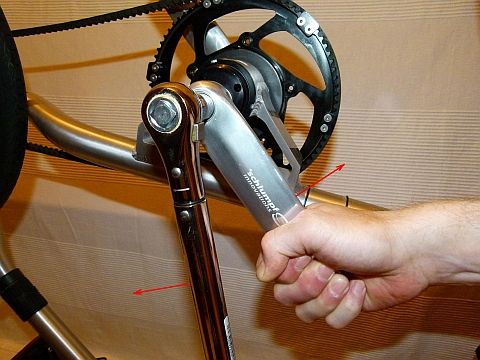
-
Mount the rear wheel bolt, washers, magnet counterpart and magnet spacer, for correct sequence please refer to the pic below or to the exploded drawing of the Strida manual (caution: do not tighten the bolt too hard - the magnet counterpart should be easily moveable - and use a thread locking compound – Loctite or similar!)

-
Mount the snubber bolt, bearing and washer (caution: washer between bearing and frame, do not forget to use Loctite!)
-
Mount the brake caliper (caution: use loctite!)
a. Take the caliper in the right hand
b. Push the first, upper washer onto the caliper
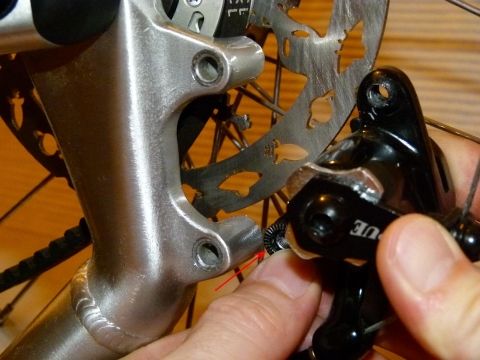
c. Slide caliper and washer behind the frame mount
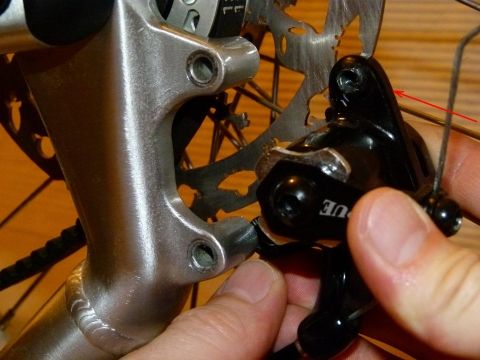
d. Press the caliper softly against the frame mount to secure the washer

e. Screw in the upper bolt (caution: do not forget Loctite!)

f. Push the second, lower washer onto the caliper

g. Rotate the caliper to the frame mount
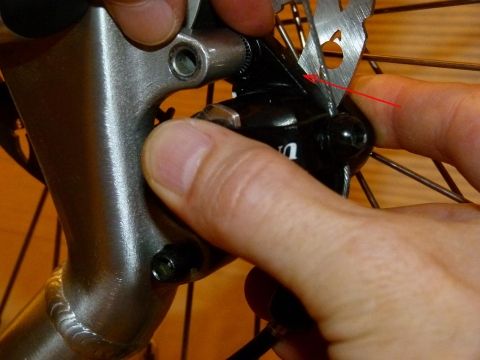
h. Screw in the lower caliper bolt (caution: use Loctite!)
i. Tighten both bolts to a torque of 8 Nm (5,9 lb ft)
j. It might be possible that the brakepads must be readjusted, please refer to the Strida manual, page 17 Strida manual revised.pdf
-
Mount the belt tension bolt (and kickstand) and adjust belt tension. (caution: the speed drive manual recommends not to use Loctite on Schlumpf parts, I mean this bolt is an exception!)
-
Tighten the big groove nut really hard, recheck belt tension
-
Mount the kick shift button(s) and adjust it (them) carefully. For this step, please refer to the Schlumpf drive manual chapter B-5 or to the information supplied with the drive.
haberstock-mobility.com/Manual Schlumpf speed drive.pdf -
Finally, mount the pedals, alternatively kick shift plates can be used. Further information about these plates is also available in the speed drive manual. To use the forum search might also be useful, keywords „kick shift plates“ and „kick shift buttons“.
Have a safe ride with your new two-speed Strida!
![]()
Hi,
I been reading this thread since yesterday, I recently bought a strida LT (single speed) to use for daily commute from home to office here in France, I thought I wouldn’t be needing the gear option that’s why I bought the LT, but i was wrong…
Is Schlumpf speed drive compatible for my LT? I’m not well verse about the gearing description. On hydra & Blackstridaaustria post, it looks like it is not advisable to do my planned upgrade.
BR,
Chris
Hello and welcome,
Yes.
I’ve meant it’s not advisable for people without some mechanical skills to do the upgrade themselves.
(And it’s still not that cheap…)
For an experienced bike mechanic should neither the ordering nor the installing of a Schlumpf drive into a Strida be a problem, I believe.
Sadly is the upgrade of an LT to a 3-speed drive (the new EVO) technically impossible, however, with the EVO you can get more gear per money.
Every (further) question about the Schlumpf drive is welcome… ![]()
^thanks for your quick response, appreciate it!
I think i can follow your procedure provided with the proper tools…
My main concern is the gear ratio, i was thinking that if i convert my lt, my low will be too low and high will be too high…
I agree that the new EVO is more gear per money, do you think it is more economical for me to buy a new EVO than buying all the tools, Schlumpf kit and making the upgrade? I thought buying a new EVO is not an option for me, my LT is only a month old…
If you convert to a Schlumpf (speed drive), the original gear ratio will be gone.
Due to the use of a 80 teeth beltwheel (instead of 100) there will be a higher and a lower ratio.
The EVO is using a 100 teeth beltwheel, the middle gear of the EVO is equal to the single speed ratio.
Yes, I do think so, anyway the EVO will be cheaper than an upgraded LT/SX.
Did you already talk to your dealer?
Maybe he is able to help you?
@ Blackstridaaustria
local dealer here in France
(that price i think is without shipping)
It is less expensive to buy in Singapore…I bought my LT there for 750SGD and EVO 3 there cost 1500SGD. (350SGD more expensive here in France)
Will my upgrade be more than 1150euro? (LT+Schlumpf+tools)
BR,
CHris